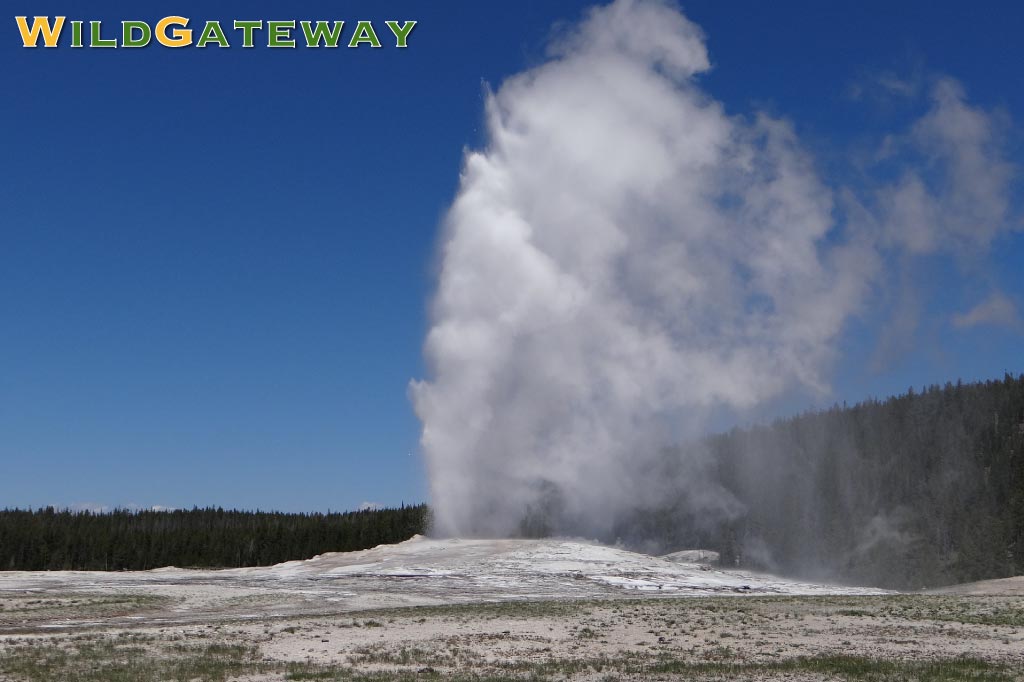Yellowstone National Park is the oldest national park in the United States, and one of the best-known. Famous for its geothermic activity, abundant wildlife and spectacular scenery, Yellowstone is one of the world’s truly special places. Emily Tubwell is smitten …
Exploring Yellowstone
Yellowstone National Park is not only the oldest national park in the United States; it’s also the world’s first ever national park. Most of the park is situated in the northwest corner of Wyoming but parts of the park also spread into neighboring Idaho and Montana.
Underneath Yellowstone’s thin veneer of serenity rage age-old volcanic forces. In many places these have broken through, filling the air with sulphuric fumes from the very depths of the Earth.
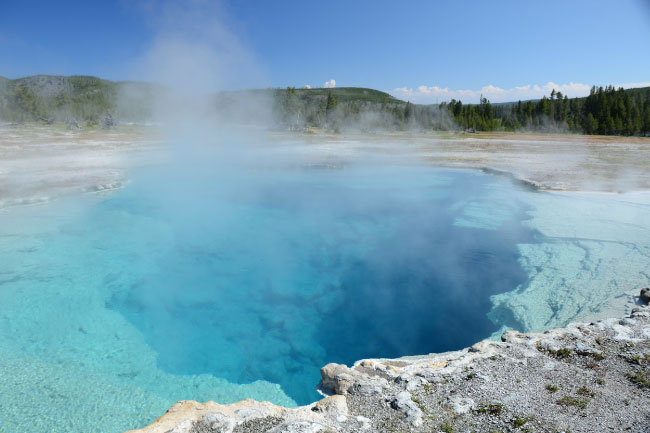
The park sits atop a super volcano. The unique landscape is formed by a massive caldera – a depression in the ground caused by the emptying of a vast magma chamber.
Although the volcano last erupted around 640,000 years ago, it’s still active. Scientists keep a close watch on the area’s volcanic activity. With thousands of minor earthquakes a year, there is continual speculation that a major eruption is due … or overdue.
As I planned my trip, disaster movie-like images were never far from my mind. However, what I actually experienced at Yellowstone couldn’t have been further from the destructive imaginings of a Hollywood director.
From the stunning landscapes and mesmerizing thermal features, to the abundant wildlife, I soon learned there is nowhere quite like Yellowstone. It’s quite simply one of the most incredible – and beautiful – places I have ever been to in my life.
On my very first drive through the park, I found a place of vast green forests, high mountain peaks and lakes that sparkled seductively in the bright morning sunlight.
Artist Point
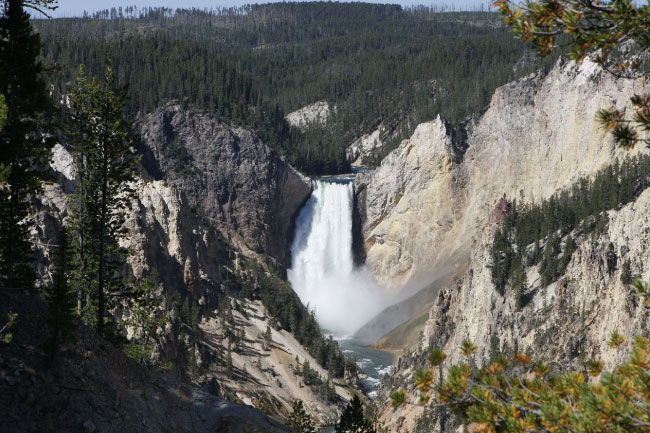
One area that I visited early on during my visit was Artist Point, a clifftop viewpoint that offers incredible views of the Grand Canyon of Yellowstone and the Lower Falls.
While the climb up the stairs to Artist Point was gruelling, it was well worth the effort. When I visited, the sun was shining and a rainbow was present over the waterfalls. Breathtaking is a word I could easily overuse when describing Yellowstone. But it was.
Geothermal Activity
Yellowstone is, of course, famous for its geothermal activity. The caldera under the park has created areas with geysers, hot springs and mud pots. Using the many wooden boardwalks, I was able to get extremely close to many of these features. When the breeze blew in my direction, the air around me was filled with steam.
Old Faithful
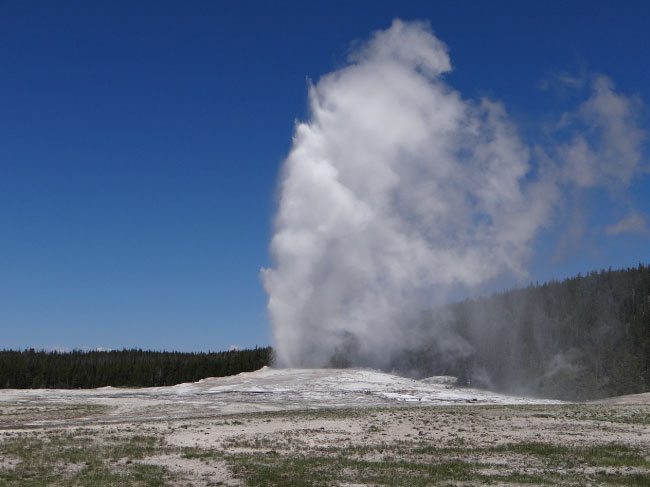
For me, the most captivating features were the geysers. There are over 300 of them in Yellowstone. The eruptions of hot water and steam were fascinating to watch and quite unlike anything I had ever seen before.
High on my list of things to see was Old Faithful. Located in the Upper Geyser Basin, this iconic geyser is one of the park’s most popular attractions. As its name suggests, it reliably erupts every 90 minutes.
Old Faithful launches up to 8,000 gallons of boiling water 184 feet into the air. Although – surprisingly – it’s neither the largest nor the highest geyser in Yellowstone, it was nevertheless an incredible sight.
Crowds of visitors gathered as it was due to erupt, adding to the atmosphere of anticipation. We gasped as steam began to rise furiously until, finally, the water was forced up, gradually increasing in height until the spout towered over us.
It was geology in the raw: an indication of the mighty forces at work under our feet. Nowhere are they more apparent than at Yellowstone.
The Norris Geyser Basin is the hottest area in Yellowstone. Exploring the Porcelain Basin area felt like visiting another planet. Aside from a few scattered trees around the edges, no other plants grew there due to the heat and acidity of the environment.
Small geysers were scattered all around, steaming and erupting, seemingly at random. The alien landscape was desolate and barren. The experience was at the same time extraordinary and unnerving.
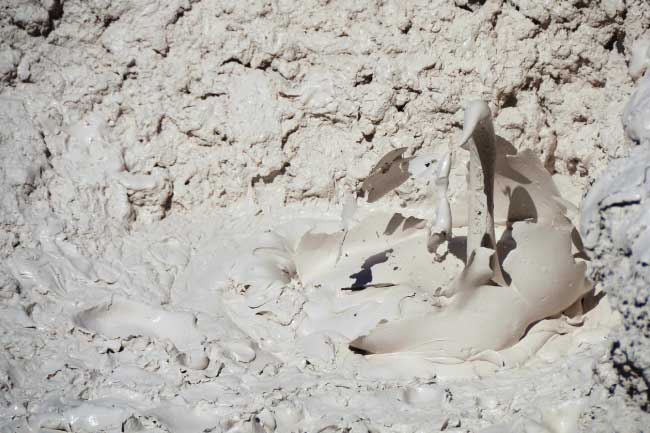
The Lower Geyser Basin is home to many different thermal features, including the Fountain Paint Pot. Here, heat beneath the ground causes the mud pot to bubble away continuously. The continual gurgling sounds were amusing, yet it was the smell of hydrogen sulphide hanging in the air that was, for me, the most striking aspect of the trail. While not particularly pleasant, one thing’s for sure: the smell will always remind me of Yellowstone.
Also worth visiting in this area is Steamboat Geyser, the largest active geyser in the world. Although there hasn’t been a major eruption for many years, even its minor eruptions are spectacular.
Grand Prismatic Spring and the Morning Glory Pool
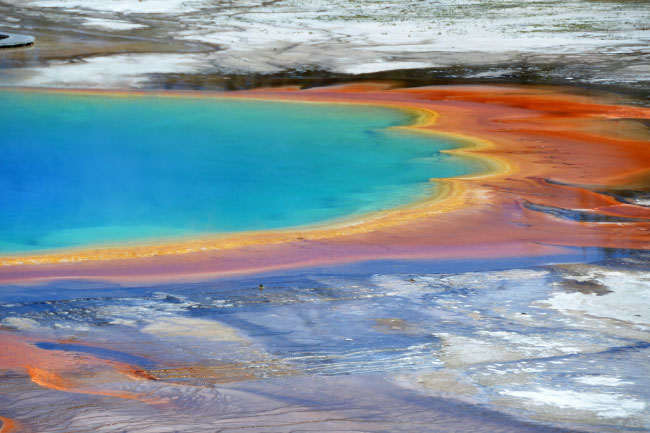
Two of Yellowstone’s most beautiful features are the Grand Prismatic Spring and the Morning Glory Pool, located in the Upper Geyser Basin. Circling the azure blue of the pools were striking rings of green, yellow and orange.
The colors were simply stunning; no photograph can do them justice. What I found fascinating was that the colors are actually caused by bacteria called thermophiles which are able to live in extremely hot environments.
Wildlife At Yellowstone
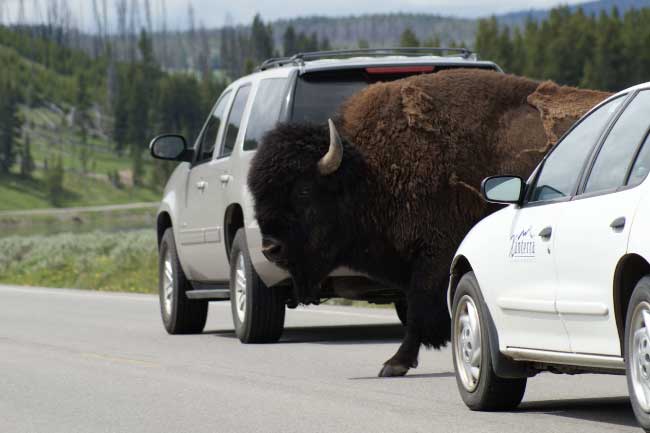
While the landscape and its thermal features are extraordinary in themselves, Yellowstone is perhaps even more famous for for its abundant wildlife.
One of my first encounters with Yellowstone’s wildlife was a ‘bison traffic jam’. I was driving through a forested area when I spotted a large object in the road ahead of me. As I approached I soon realized that it was a large bison, apparently happy making its way slowly down the middle of the road. I had no choice but to slow down and follow the large animal as it sauntered along.
Eventually, the bison strayed off on to the other side and I was able to pass. I felt honored to have been able to come so close to such a formidable animal. I’d had time to marvel at its horns, shaggy fur and brown beard; I could even see the matted dirt on its back. These massive animals can run up to 40 miles per hour and are incredibly powerful, yet this one seemed so docile.
Later, and much to my surprise, I even saw a bison wandering very close to one of the geyser sites.
Being open spaces, Lamar Valley and Hayden Valley are ideal spots for observing wildlife, especially bison.
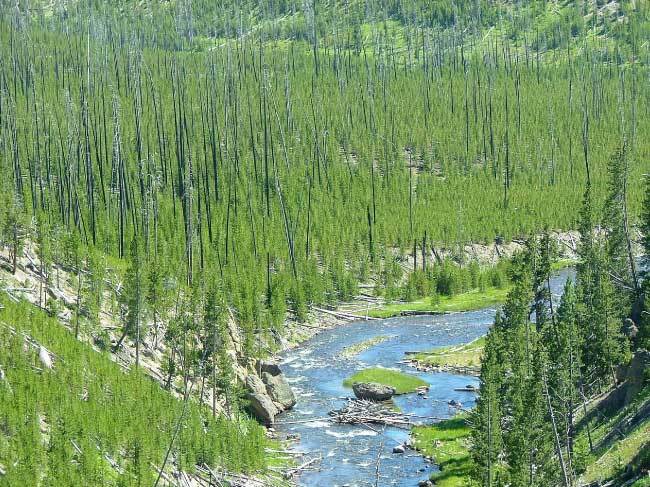
Wildlife can be seen throughout the park and when you are driving, keep an eye out for animals in the trees and covered areas.
Finding elk, deer and pronghorns is no problem; they are frequently spotted in the forests and valleys and are very elegant and amusing animals to watch. With a bit of effort, I also managed to spot bighorn sheep perched on steep cliffs and high slopes.
Bears & Wolves
There is a certain amount of luck involved in spotting what some consider to be the real ‘stars’ of Yellowstone’s animal cast: the wolves and the bears.
I was fortunate enough to catch a glimpse of black bear cubs playing on a log while I drove past a heavily forested area. To see these iconic animals wild and free in their own habitat was incredible.
Park rangers are often present to protect the animals, and in certain circumstances will ask you to move on if either you or the animals are getting too close. This is understandable; Yellowstone is, of course, as much for the animals as it is for us.
Conclusion
With its breathtaking scenery, abundant wildlife and spectacular thermal features, this awe-inspiring park truly feels alive. It is a place for observation, reflection and learning.
I was lucky enough to spend several days at Yellowstone, but it was nowhere near enough. It’s easy to underestimate just how many amazing things there are to experience in the park.
With endless trails to explore and a landscape that changes from season to season, no two trips will ever be the same. I wouldn’t hesitate in returning to Yellowstone; it is truly one of the world’s special places. Prepare to be blown away by its wondrous beauty.

